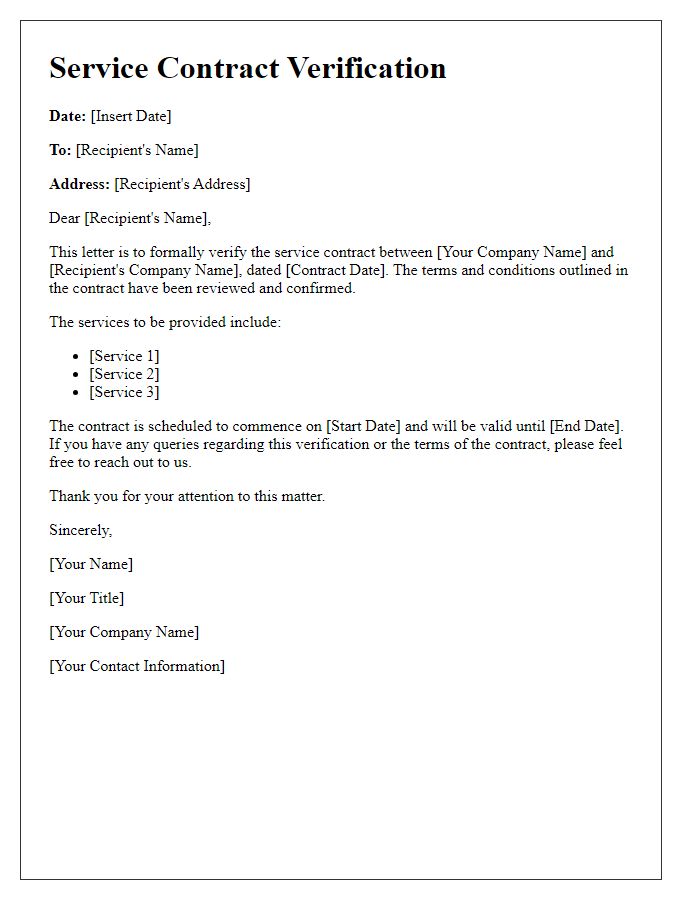Welcome to our guide on confirming service contracts! In today's fast-paced world, clear communication is essential for fostering strong professional relationships. A well-crafted letter not only confirms the details of the contract but also sets a positive tone for collaboration ahead. Ready to dive into the specifics and learn how to create your own confirmation letter? Keep reading!

Introduction and Greetings
Service contract confirmation involves formal acknowledgment of an agreement between involved parties, typically a service provider and a client. The introduction emphasizes the significance of clarity, outlining key details such as contract dates, scope of services provided, and any specific terms agreed upon. Greetings convey professionalism, fostering a positive relationship between the parties. A well-structured confirmation reaffirms commitment to quality and reliability in service delivery, ensuring both parties have a mutual understanding of expectations and responsibilities integral to the contract.
Confirmation of Service Agreement Details
A service contract confirmation outlines the specific terms and conditions agreed upon between parties involved in a business relationship. The contract should specify the parties' names, their roles, the effective start date, and the duration of the contract in months or years. It should clearly define the scope of services to be provided, such as maintenance, consulting, or supply of goods, detailing any specific milestones or deliverables. Additionally, the confirmation should include payment terms outlining the total cost, payment schedule, and any penalties for late payments. Important clauses, such as confidentiality agreements, termination rights, and dispute resolution procedures, must also be present to ensure clear channels of communication and problem-solving. Including contact information for key representatives from each party can facilitate effective coordination throughout the contract period.
Terms and Conditions Summary
Service contracts, essential for defining agreements between parties, often include critical elements such as duration, pricing, service scope, and termination conditions. The contract typically specifies a start date, for example, March 1, 2024, and an end date, like February 28, 2025, establishing a one-year commitment. Pricing structures may include monthly fees of $500 or one-time charges for specific tasks, ensuring transparent financial obligations. The scope of services often highlights deliverables, such as monthly maintenance checks or support response times of 24 hours. Termination clauses specify conditions under which either party can exit the agreement, such as a 30-day notice period. Understanding these factors ensures clarity and mutual agreement between all involved parties.
Contact Information for Queries
Service contracts often include essential contact information for queries, ensuring clear communication between all parties. Accurate details such as phone numbers (like customer service 1-800-555-0199) and email addresses (for instance, support@contractservices.com) are crucial for quick assistance. The addition of a designated point of contact (such as a contract manager named John Doe, reachable at john.doe@contractservices.com or extension 124) enhances the process. Providing business hours, like Monday to Friday from 9 AM to 5 PM, highlights availability for inquiries, improving customer satisfaction and responsiveness during service delivery.
Closing Remarks and Signature
Service contracts play a pivotal role in formalizing agreements between parties for specific services. Key components include the service scope, duration, payment terms, and responsibilities. Thorough language clarifies obligations, ensuring that both providers and clients understand expectations. Closing remarks summarize mutual agreement, reaffirming commitment to uphold the contract's terms. A signature signifies legal acceptance, binding both parties to the outlined stipulations. Furthermore, an effective contract typically includes provisions for breach resolutions and amendment processes, enhancing clarity and reducing the potential for disputes. Ensuring all details are explicit underpins a successful professional relationship.













Comments